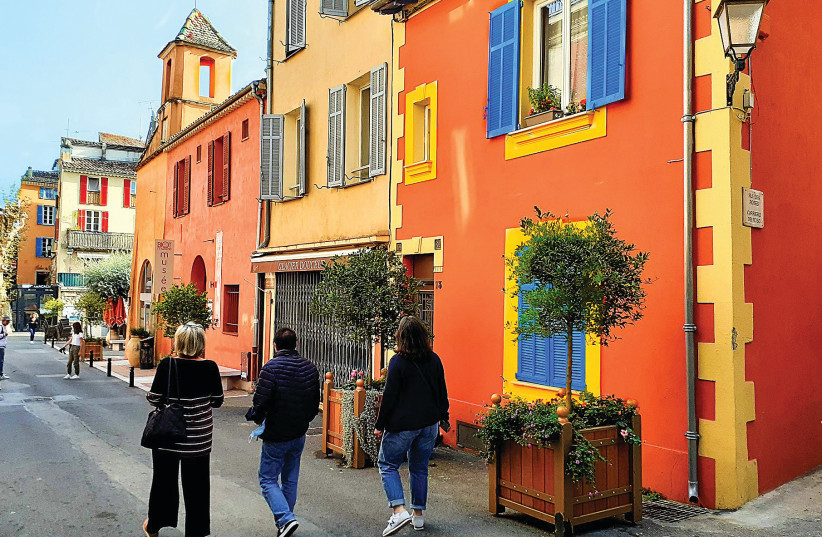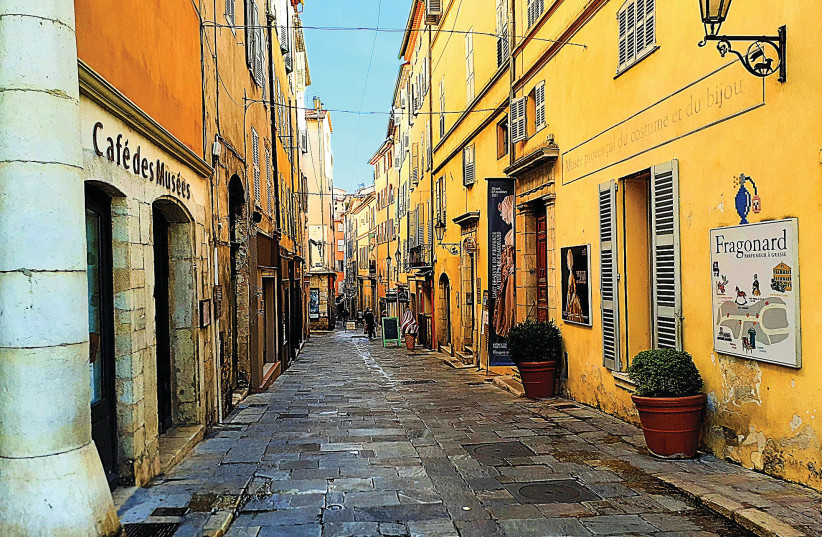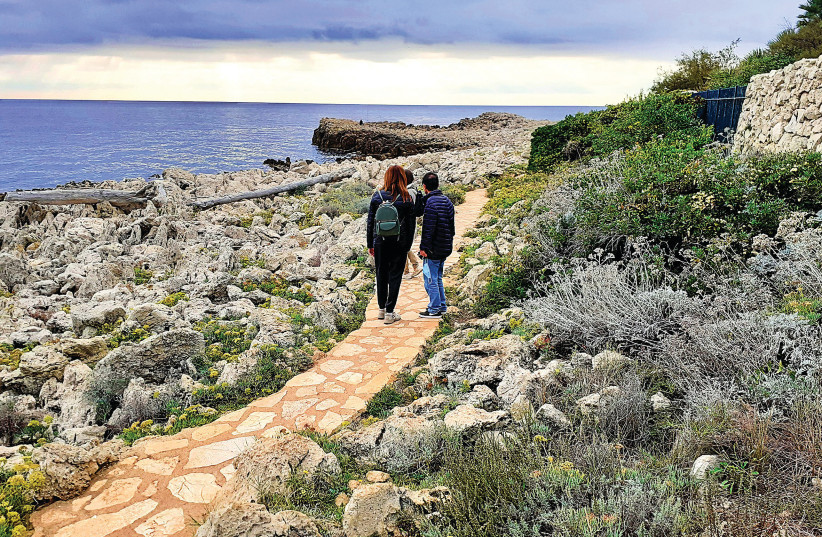Like most people, I had not traveled overseas since before the pandemic began. So when The Jerusalem Post tapped me to represent the paper on a weeklong VIP press tour to the French Riviera (you really ought to consider working for a newspaper...) I was concerned about the requirements ensuring safe travel in this not-yet-post-COVID era.
I was pleasantly surprised. Corona safety is now tourist-friendly and efficient.
Hopefully by the time you read this or embark your own trip to the stunning Cote D’Azur (French Riviera) region, the pandemic will be a fading memory, but for now here’s what you need to know:
To travel: An immunization certificate is all you need to fly to France (no COVID test). Keep it handy; its QR-code is scanned every time you enter a hotel, restaurant or museum. Indoor masking is scrupulously observed.
To return: You do one COVID test (with a negative result) 72 hours before boarding a plane back to Israel, and a second test after landing at Ben-Gurion Airport, isolating at home until you receive the negative results by email (about eight hours later).

That’s it.
The COVID safety requirement is minimal and well worth the effort, safeguarding everyone’s health while you explore and enjoy one of the most beautiful and diverse travel destinations in the world.
What exactly is the French Riviera?
North of its border with Portugal, facing Britain and the Atlantic Ocean, France has a long stretch of western coast with its own rugged beauty, but tucked away in France’s warm sunny southeastern corner near Monaco and Italy – scenically sandwiched between the azure-to-cobalt-blue shades of Mediterranean Sea and the rocky, green-treed Alps – is the Cote D’Azur.
Its location made it a key center for the Greeks and Romans; its mild winter climate made it a winter haven and resort for European aristocrats and monarchs such as King Leopold II of Belgium and Queen Victoria of England; and the natural beauty of its sparkling waters, mountains and charming colorful scenic streets made it a magnet for a long list of notable artists and writers: Pablo Picasso, Claude Monet, Paul Cezanne, Henri Matisse, Marc Chagall, Edvard Munch, Jules Verne, F. Scott Fitzgerald, Ernest Hemingway and many more.
From your first glimpse of this dazzling region, it will be clear to you what makes it so captivating and inspirational.

Getting to Cote D’Azur
Round-trip flight prices to France are surprisingly affordable; a quick search shows options even under $200.
As guests of the French Tourist Board, we flew to Paris in one of the newest and most advanced planes in the sky: the Air France A350 Airbus. Perhaps because I usually opt for the most cut-rate and cramped option possible, I was surprised and impressed by the aircraft’s innovative interior design and feeling of spaciousness.
The economy premium section that we were in provides an unusual amount of personal space – wide seats and full stretch-out legroom. The excellent video screen, audio quality and extensive content menu made our too-short flight time, well, fly by.
A peek into the business class section revealed individual futuristic space-age luxury pods the likes of which I could never have envisioned – and will probably never experience.
After an overnight stay in the Paris Pullman Hotel, conveniently located literally just a few steps from the Charles de Gaulle Airport (no taxi needed), a short flight brought us to the Cote D’Azur, where we would spend four memorable days.

Yes, we Cannes
One good way to cope with the sensory overload when you first enter Cannes is to go for an early-morning electric bike guided excursion through the streets and foothills so that you can begin to process the charm of the town and the breathtaking views from the heights overlooking it.
Famous for hosting the Cannes Film Festival, the city’s natural beauty is complemented by the glamour bestowed by an endless stream of celebrities, many of whose handprints and signatures are embedded Hollywood-style in squares on the ground: Meg Ryan, Sylvester Stallone and more than 100 others (I looked at them all and photographed favorites). The main coastal artery running along the gleaming shore boasts glittering store fronts of almost every luxury brand you can think of: Gucci, Cartier, Celine, Chanel, Dior, Jean Paul Gaultier, etc.
For normal people like us not evading paparazzi, there is the inviting beach and a long, broad scenic walkway (tayelet). Strolling on it past a marina chock full of impressive expensive luxury yachts, our group boarded a small motorboat for Ile Saint Honorat, the second largest of the four Lerin Islands off the coast, a quiet, lush protected natural haven with a historic classical-style ornate monastery that has been home to a community of monks since the fifth century. Well worth a visit and an interesting contrast to the bustle and glamour of the city.
We stayed at one of the city’s three most legendary hotels in demand by celebrities: the five-star Martinez, built in an exquisite magnificent architectural style unequaled since it went up the 1920s. The suite I was honored to occupy was the most impressive hotel accommodation I have ever experienced or will probably ever have an opportunity to stay in again. I can only imagine which notables have slept in that very room through the years.
While there, we were taken on a tour of the penthouse suites. Incredible as it may sound, there is a celebrity suite that is over 1,000 square meters – with many, many rooms. Every inch of it gleams with the most expensive furnishings and imaginative fixtures and décor one can dream of. It provided an unforgettable eye-opening glimpse of how the truly rich and famous can live. And for only €35,000 a night, you too can stay there! But for those of us on more of a budget, rooms at this impressive hotel start (depending on the season) at a surprisingly affordable €230. The experience is more than worth it.
Grasse is greener – and more fragrant
The second day we left the coast and took to the hills.
The picturesque town of Grasse, perched high in the mountains with spectacular forest views in every direction, has been the center of the French perfume industry for centuries and is considered by many as the world’s perfume capital. We toured the iconic Musée International de la Parfumerie (International Museum of Perfumery), the planet’s only perfume museum.
After a guided tour of the surprisingly extensive collection of rare items tracing the history of perfumery, we took part in a workshop making perfume at the world-famous Fragonard perfume factory and witnessed the production facility in operation – a fascinating learning experience whether you are a perfume connoisseur or not.
As if that weren’t enough, we then strolled wide-eyed through the alleys of the medieval town center where time stopped: narrow street after street of pastel-colored 15th and 16th century homes and stores essentially unchanged since medieval times. If you are planning to film a full-length epic film about the Middle Ages, do it here and you won’t have to build a single set. Wandering the streets is a dreamy TARDIS-free time-travel experience.
Afterward we explored the small fortified hilltop town of Biot, another stunningly beautiful medieval village perched with charming ancient streets set in the verdant heights of the Alps. World-renowned for its ceramics and glassblowing art, Biot dates back to the Middle Ages and beyond (and the historic old city looks it). At the famous Verrerie de Biot factory we observed master glassmakers at work and gazed into glass display cases exhibiting incredible glass artwork masterpieces.
Antibes and Nice: Couldn’t be nicer
Our third day began in Antibes, an enchanting seafront town between Cannes and Nice whose history goes back beyond the fifth century BCE, and about which Victor Hugo said, “Everything here is radiant, everything is in bloom, everything sings. The sun, women, love are all at home here. My eyes and my soul are still dazzled.”
Douglas Fairbanks, Mary Pickford, Rita Hayworth, Marlene Dietrich, Charles de Gaulle and Pablo Picasso were among the many notables intoxicated by the charm of this community through the years.
The highlight of our visit was a five-kilometer hike around the scenic perimeter of the Cap d’Antibes peninsula, an isolated and mostly uninhabited nature-protected paradise with magnificent landscapes in every direction: sea, rocks, mountains and rich exotic flora.
Another must-mention: our visit to the Antibes Picasso Museum in the legendary Grimaldi castle, which has been dominating the seafront skyline since at least the 1500s. The impressive structure and the extensive display of the master’s artwork symbiotically complement each other.
We ended the day literally following in the footsteps of Marc Chagall to the gorgeous mountaintop town of St. Paul de Vence, witnessing key places where the painter lived, strolled, created his incomparable artwork and is buried.
Our visit ended the next day at Nice, the largest and most impressive town on the French Riviera. After examining a wide range of Chagall’s masterpieces in the Nice Chagall Museum, we explored the extensive network of colorful walkways, architectures and markets of the Old City and then emerged into the new city, with ultra-modern stores, malls, light rail, etc. I noted with marvel and duly record that throughout my stay I saw virtually no graffiti, no litter, no traffic congestion and heard no honking horns. If this sounds unbelievable to you, go see for yourself.
I spent my last hour of free time walking along the scenic beachfront tayelet and strolling barefoot among the many late October bathers at the azure water’s edge.
If French cuisine is your scene…
Did I neglect to mention the food?
It is said that French cuisine is the apex of culinary artistry, romance and gastronomical luxury, and our press group was feted at some of the top restaurants in the region headed by famed chefs who fully deserve their reputations.
For those of you with refined gustatory sensibilities, I can report that the food looked spectacular: elegantly presented, served imaginatively – like artwork – more than appetizing. My companions in the press corps avidly photographed all entrées and desserts before hungrily attacking them with their utensils.
Although I am unable to report first-hand how the food tasted (I travel with my own kosher food), the body language and exclamations of my colleagues amply testified to their enthusiastic endorsement.
Having wandered around the towns a bit in the evenings, I can verify that there are also a few kosher eateries (and synagogues) in the main tourist areas.
Final musings of a novice traveler
In three-and-a-half days packed with touring and sightseeing, we managed to experience a lot, but still saw only a fraction of what the Cote D’Azur has to offer. From well-preserved archaeological sites to modern hi-tech cities and the latest box-office films and stars, from glitz and glamour to profoundly quiet nature reserves; from swimming in clear azure waters to skiing on majestic snow-capped mountains, from sumptuous meals to niche industries, major museums, giant water parks and more – this incredible region has much to offer for every age and taste – all packaged in a lovely compact accessible area with a great climate.
As a guest of the French Tourism Ministry, I am expected to write positively about this region, but my enjoyment and enthusiasm are genuine and far beyond my capacity to express adequately in words.
The Talmud says that of the ten measures of beauty given to the world, Jerusalem received nine while the rest of the world received one. If so, the Cote D’Azur clearly was generously dealt numerous extra portions.
There are many awe-inspiring and worthwhile places to visit in this world of ours and for me the French Riviera is now high on the list. I intend to return, this time bringing my wife, and my warm recommendation is that you consider adding it to your hope-to-do list too.
The writer was a guest of the French Tourism Board in Israel.
